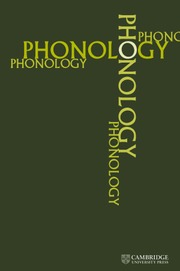Footed tones and tonal feet: rhythmic constituency in a pitch-accent language
Published online by Cambridge University Press: 21 November 2002
Abstract
While prosodic systems are typically either tonal or metrical, composite systems including both tone and metrical structure present yet another, albeit less frequent, possibility (Prince 1983, Hayes 1995). The focus of this paper is a prosodic system of the latter, more complex variety, evidenced in the Neo-štokavian dialect of Serbian or Croatian (henceforth NS; see Ivić 1958, 1985, Zec 1993). Although previously analysed as a pitch-accent system with no role allotted to the rhythmic structure (Browne & McCawley 1965, Ivić 1965, 1976, Halle 1971, Kenstowicz 1974, Lehiste & Ivić 1986, Inkelas & Zec 1988), on closer inspection NS discloses important resemblances with stress systems. Metrical structure is an independent agent in NS, as will be demonstrated here, and the entire prosodic system is characterised by a rich interplay between the tonal and metrical components.
Co-presence of tone and foot structure may in principle result in several types of interfaces between these two components. Cases documented in the literature are of two types: those in which the distribution of tone is constrained by metrical constituency, and those in which constraints operate in the opposite direction. third type of case has also been documented. In Japanese, as analysed in Poser (1984, 1990), the accentual system is tonal in nature while various templatic phenomena call for an inventory of iambic feet, yet the two systems are independent of each other and do not interact. The former type is exemplified by a number of languages extensively discussed in the literature: Creek (Haas 1977, Halle & Vergnaud 1987), Kirundi (Goldsmith 1987, Goldsmith & Sabimana 1989, Hayes 1995), Seneca (Prince 1983: 82–86), Winnebago (Susman 1943, Miner 1979, 1981, 1989, Halle & Vergnaud 1987, Hayes 1995 and the references therein) and Ancient Greek (Golston 1989, Sauzet 1989). The other type of unilateral interactions, with the rhythmic structure dependent upon the distribution of tone, is instantiated, for example, by Golin (Bunn & Bunn 1970, Hayes 1995).
In contrast, NS presents a case of bilateral interaction between tone and foot structure: tone exerts influence on the repertory of feet, and foot structure, in turn, constrains the distribution of tone. Although previously analysed as an instantiation of unilateral interaction, on a par with Golin (Inkelas & Zec 1988, Hayes 1995), new evidence to be presented here clearly disputes this position. This case is of immediate theoretical relevance for establishing the range of possible foot inventories. The resulting inventory is richer than in cases generally reported in the theoretical literature (Prince 1990, Mester 1994, Hayes 1995), and as such suggests a possible direction in which foot inventories may expand.
- Type
- Research Article
- Information
- Copyright
- © 1999 Cambridge University Press
Footnotes
- 21
- Cited by




